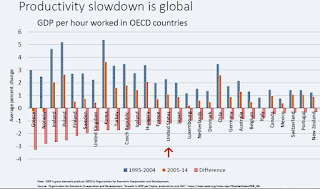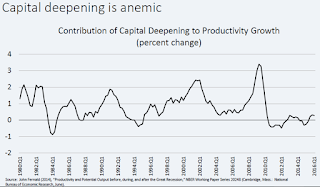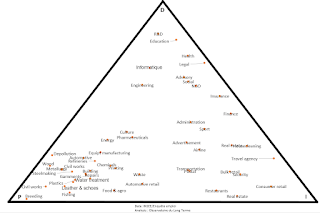Published in Huffington Post, Us Edition.
Not one day goes by without hearing about predictions
of massive job losses due to « Uberisation ». However, statisticians find it hard to read the effect
of said Uberisation outside of a very narrow set of sectors (car
transportation, rental of apartments, etc.). Furthermore micro-economic studies
tell a quite different story for sectors outside this set. In manufacturing
[1], for example, the way production adapts to new technologies is very slow
and incremental. Productivity gains may indeed have many causes, such as additive
manufacturing (“3D printing »), increased digitization of processes made
possible by the price drop of sensors and of information processing, or a simply
better organization of the manufacturing chain. As a consequence, each year,
industrial productivity naturally increases by a few percentage points, even in
the absence of any technological/business model disruption. Actually if
something new is happening in the industrial sectors it is rather a deceleration
in productivity gains and productivity investments rather than an acceleration!
of massive job losses due to « Uberisation ». However, statisticians find it hard to read the effect
of said Uberisation outside of a very narrow set of sectors (car
transportation, rental of apartments, etc.). Furthermore micro-economic studies
tell a quite different story for sectors outside this set. In manufacturing
[1], for example, the way production adapts to new technologies is very slow
and incremental. Productivity gains may indeed have many causes, such as additive
manufacturing (“3D printing »), increased digitization of processes made
possible by the price drop of sensors and of information processing, or a simply
better organization of the manufacturing chain. As a consequence, each year,
industrial productivity naturally increases by a few percentage points, even in
the absence of any technological/business model disruption. Actually if
something new is happening in the industrial sectors it is rather a deceleration
in productivity gains and productivity investments rather than an acceleration!
The issue is therefore not to brandish the digital
threat some gurus and consultants like to evoke, but rather to understand the
nature of such threat to the existing organization of a given value chain. In
many cases, the threat is more likely to come from a competitor – who may be
quicker than you in using digital in order to increase performance, or to propose
innovative services – instead of an Internet giant or a start-up popping up out
of the blue. There is real risk of investing too much to counter a theoretical Uberisation,
and there is also real risk in not investing enough to reinforce your own
productivity and quality of service. These poor investment choices, fueled by hazardous
extrapolations and narratives, brings either inspiring optimism to investors or
fears to businesses. That is precisely the definition a bubble [2].
threat some gurus and consultants like to evoke, but rather to understand the
nature of such threat to the existing organization of a given value chain. In
many cases, the threat is more likely to come from a competitor – who may be
quicker than you in using digital in order to increase performance, or to propose
innovative services – instead of an Internet giant or a start-up popping up out
of the blue. There is real risk of investing too much to counter a theoretical Uberisation,
and there is also real risk in not investing enough to reinforce your own
productivity and quality of service. These poor investment choices, fueled by hazardous
extrapolations and narratives, brings either inspiring optimism to investors or
fears to businesses. That is precisely the definition a bubble [2].
Not all sectors are affected in the same way. In
transportation, Uber “disrupts” the « interaction » jobs (which are
about the relation between a cab and a customer), not the
« production » jobs (Uber does not decrease the number of people driving
a car). The “design” jobs (management, design, artists…) are still far from
being disrupted: at best, artificial intelligence provides them with tools
eliminating a small and repetitive part of their job. In the case of Uber,
interaction and production jobs are complement, not substitutes: the lower the
cost and the complexity of the former, the more plentiful the latter. Cab
companies owners, call centers operators, and taxi licenses owners can indeed
worry about Uberisation. But drivers shouldn’t as Uberisation leads to a net increase
in the number of driver jobs, and this is a net gain for society as a whole
after taking into account customers’ surplus in the tally. Please also note
that we’re still very far from the driverless cabs – plane “autopilots” have
been existing for years, and they still need a human supervision.
transportation, Uber “disrupts” the « interaction » jobs (which are
about the relation between a cab and a customer), not the
« production » jobs (Uber does not decrease the number of people driving
a car). The “design” jobs (management, design, artists…) are still far from
being disrupted: at best, artificial intelligence provides them with tools
eliminating a small and repetitive part of their job. In the case of Uber,
interaction and production jobs are complement, not substitutes: the lower the
cost and the complexity of the former, the more plentiful the latter. Cab
companies owners, call centers operators, and taxi licenses owners can indeed
worry about Uberisation. But drivers shouldn’t as Uberisation leads to a net increase
in the number of driver jobs, and this is a net gain for society as a whole
after taking into account customers’ surplus in the tally. Please also note
that we’re still very far from the driverless cabs – plane “autopilots” have
been existing for years, and they still need a human supervision.
In order to estimate the overall impact of Uberisation
on employment, we used micro-level employment data broken down across 88 industries
(retail, metallurgy, publishing, and building construction …) and across different
functions (production, interaction and design). This data is available for
France, but there is no reason why the results would be significantly different
elsewhere. In our model, « production » and « design » activities are affected
by productivity gains (use of machines, robots for production, artificial
intelligence…) but they don’t disappear entierely. We show that “interaction” jobs
may however be replaced entirely by the Uberisation process.
on employment, we used micro-level employment data broken down across 88 industries
(retail, metallurgy, publishing, and building construction …) and across different
functions (production, interaction and design). This data is available for
France, but there is no reason why the results would be significantly different
elsewhere. In our model, « production » and « design » activities are affected
by productivity gains (use of machines, robots for production, artificial
intelligence…) but they don’t disappear entierely. We show that “interaction” jobs
may however be replaced entirely by the Uberisation process.
Our analysis was completed using industry experts’
assessments, we also took into account the dynamics of demand. For example, healthcare services are
expected be digitized, but the increasing structural demand for such services ensures
that, in the long run, there is no risk of a decline
in employment.
assessments, we also took into account the dynamics of demand. For example, healthcare services are
expected be digitized, but the increasing structural demand for such services ensures
that, in the long run, there is no risk of a decline
in employment.
Our model estimates that, in the medium term, 14 % of
the total employment could be displaced by digital. This can of course just be an
order of magnitude, but it is consistent with other studies (for the same
country, OECD’s estimate is 9%)[4].
the total employment could be displaced by digital. This can of course just be an
order of magnitude, but it is consistent with other studies (for the same
country, OECD’s estimate is 9%)[4].
It shows that the reality is very far from the scary
situation where all jobs are eaten away by robots powered by artificial
intelligence. It quantifies a reality: some jobs are indeed made redundant by
digital, and they are the ones the most visible – the « interaction »
jobs (sales staff, call centers…). But millions of « production »
jobs (construction, garbage collection,…) are hardly affected. Industrial
jobs do indeed see annual productivity gains, but the size of such gains has
been decreasing, not increasing, in the last decade.
situation where all jobs are eaten away by robots powered by artificial
intelligence. It quantifies a reality: some jobs are indeed made redundant by
digital, and they are the ones the most visible – the « interaction »
jobs (sales staff, call centers…). But millions of « production »
jobs (construction, garbage collection,…) are hardly affected. Industrial
jobs do indeed see annual productivity gains, but the size of such gains has
been decreasing, not increasing, in the last decade.
Structure of the jobs by
industry
industry
This figure represents the
structure of the jobs of each industry in the economy. The position of each
industry relative to the vertex “I”, “P” and “D” represents the share of
Interaction, Production and Design jobs in this industry. For example,
industries with 100% of Interaction jobs would be represented in the vertex “I”
and industries with equal shares of Interaction, Production and Design jobs
would be represented at the center of the triangle. Based on the study
mentioned in this article, the closer to the vertex “I”, the more menaced for
“Uberisation”.
structure of the jobs of each industry in the economy. The position of each
industry relative to the vertex “I”, “P” and “D” represents the share of
Interaction, Production and Design jobs in this industry. For example,
industries with 100% of Interaction jobs would be represented in the vertex “I”
and industries with equal shares of Interaction, Production and Design jobs
would be represented at the center of the triangle. Based on the study
mentioned in this article, the closer to the vertex “I”, the more menaced for
“Uberisation”.
Our model also reveals some winning sectors. They are
the ones complementary to interaction jobs: the simpler and the cheaper the
interactions, the more customers will consume services sold through theses
interactions. Farmers are already experiencing a maximum level of competitive
pressure from purchasing groups. An Uber for fruit and vegetables (which would
be delivered directly to customers) could hardly reduce their margins even
more. On the other hand, it could allow customers to raise the level of quality
and increase the farmer’s revenues. As mentioned above, a decrease in
interaction costs will lead to an increase in production demands – efficiency
gains are not “lost”, but reallocated somewhere. Finally, the economy is not
inert: in France, 15% of all jobs are destroyed every year and the same
percentage are created because of evolutions related to technology (more renewable
energy jobs and less jobs related to coal), competitiveness (exchange rate
variations, know-how development…) or consumer tastes (more e-cigarette and
less mobile phone shops). The impact of Uberisation (14% of employment over
several years) is not much compared to Schumpeterisation (15% of employment each
year)!
the ones complementary to interaction jobs: the simpler and the cheaper the
interactions, the more customers will consume services sold through theses
interactions. Farmers are already experiencing a maximum level of competitive
pressure from purchasing groups. An Uber for fruit and vegetables (which would
be delivered directly to customers) could hardly reduce their margins even
more. On the other hand, it could allow customers to raise the level of quality
and increase the farmer’s revenues. As mentioned above, a decrease in
interaction costs will lead to an increase in production demands – efficiency
gains are not “lost”, but reallocated somewhere. Finally, the economy is not
inert: in France, 15% of all jobs are destroyed every year and the same
percentage are created because of evolutions related to technology (more renewable
energy jobs and less jobs related to coal), competitiveness (exchange rate
variations, know-how development…) or consumer tastes (more e-cigarette and
less mobile phone shops). The impact of Uberisation (14% of employment over
several years) is not much compared to Schumpeterisation (15% of employment each
year)!
There is no doubt that digitization will reduce the
number of jobs in some sectors and increase it elsewhere. With each technological
wave, there are risks for some jobs categories, but also opportunities for jobs
and value creation. It is better to start with factual and realistic numbers in
order to better deal with such risks and grasp such opportunities.
number of jobs in some sectors and increase it elsewhere. With each technological
wave, there are risks for some jobs categories, but also opportunities for jobs
and value creation. It is better to start with factual and realistic numbers in
order to better deal with such risks and grasp such opportunities.
Vincent Champain, senior executive in a multinational
company and president of the Long Term Observatory think tank, and Frederic
Benque, investment partner at
NextWorld. Many thanks to Joyce Bessis for her help on the
translation.
company and president of the Long Term Observatory think tank, and Frederic
Benque, investment partner at
NextWorld. Many thanks to Joyce Bessis for her help on the
translation.
[2] Definition of Professor Robert Schiller, expert on
bubbles in « Rising Anxiety That Stocks Are Overpriced », New York Times,
27/8/2015.
bubbles in « Rising Anxiety That Stocks Are Overpriced », New York Times,
27/8/2015.
[3] Employment Study 2013, Data from INSEE



